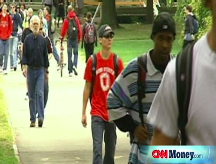College costs rise
Overall costs of attending private school increased 4.8%, while in-state public school costs rose 5.7% from previous school year, College Board says.
NEW YORK (CNNMoney.com) -- The total cost of going to a private four-year college rose to $34,132 on average for the 2008-09 academic year, according to a report released Wednesday.
In-state students at public four-year schools paid an average of $14,333 for the current school year, according to the College Board, a non-profit association of more than 5,400 schools, colleges and universities. That's an increase of 5.7% from the previous year.
Out-of-state students at public four-year schools pay a total of $25,200, up 5.2% from last year.
Total figures include tuition and fees plus room and board.
After factoring in the average $10,200 of grants and tax benefits, the tab for private-school students fell to $23,932, according the the report.
Full-time undergrads at public four-year schools received about $3,700 in aid and benefits, which lowered the actual cost of attending public schools to $10,633, or $21,500 for out-of-state students.
Outlook: With the economy slowing, students at state schools may see further tuition hikes.
As states cut back on expenditures due to budget shortfalls, subsidies for higher education are often the first items to be cut, according to Tony Pals, spokesman for the National Association of Independent Colleges and Universities, a group that represents more than 1,000 private non-profit schools in Washington, D.C.
Private schools, however, won't be able to hike tuitions as high, since families may be more sensitive to price changes in a down economy. Private institutions may instead be forced to freeze hiring, delay building projects and make other cutbacks, said Pals.
Affordability: As the cost of education increases, so does the need for financial assistance for students.
The changing income levels of American families between 1977 and 2007 has had a large effect on the ability of many to pay for school. Household incomes for the poorest families rose only 3% in that time period, while middle income families saw their incomes rise by 22%, according to the College Board.
The disparity has caused many schools to stretch their budgets and cut costs to make their services accessible, according to Sandy Baum, professor of economics at Skidmore College, and the College Board's senior policy analyst..
Grants and other forms of aid available to students can lower the out-of-pocket costs significantly.
"Institutions are spending greater proportions of their budgets on financial aid ... because they know families and students can't pay published prices," Baum said on a conference call.
Total student aid has jumped by 5.5% in inflation-adjusted dollars in the 2007-08 year, according to the College Board. Over the past decade, total aid has risen by 84%.
Last year, the federal government distributed Pell Grants - money to low income individuals who couldn't ordinarily afford college - to 5.4 million students. Each recipient received an average of $2,649. Most came from families with incomes below $40,000 a year.
Across the board, undergrads received an average of $8,896 in financial aid, which included $4,656 in grants, and $3,650 in federal loans.
Some of the most expensive colleges have the most cash available to give away as grants, according to Baum.
Putting away $100 a month for 18 years could yield between $35,000 and $40,000 that can go toward a child's education, the College Board noted, and state-sponsored 529 college savings accounts accumulate interest tax free. ![]()



